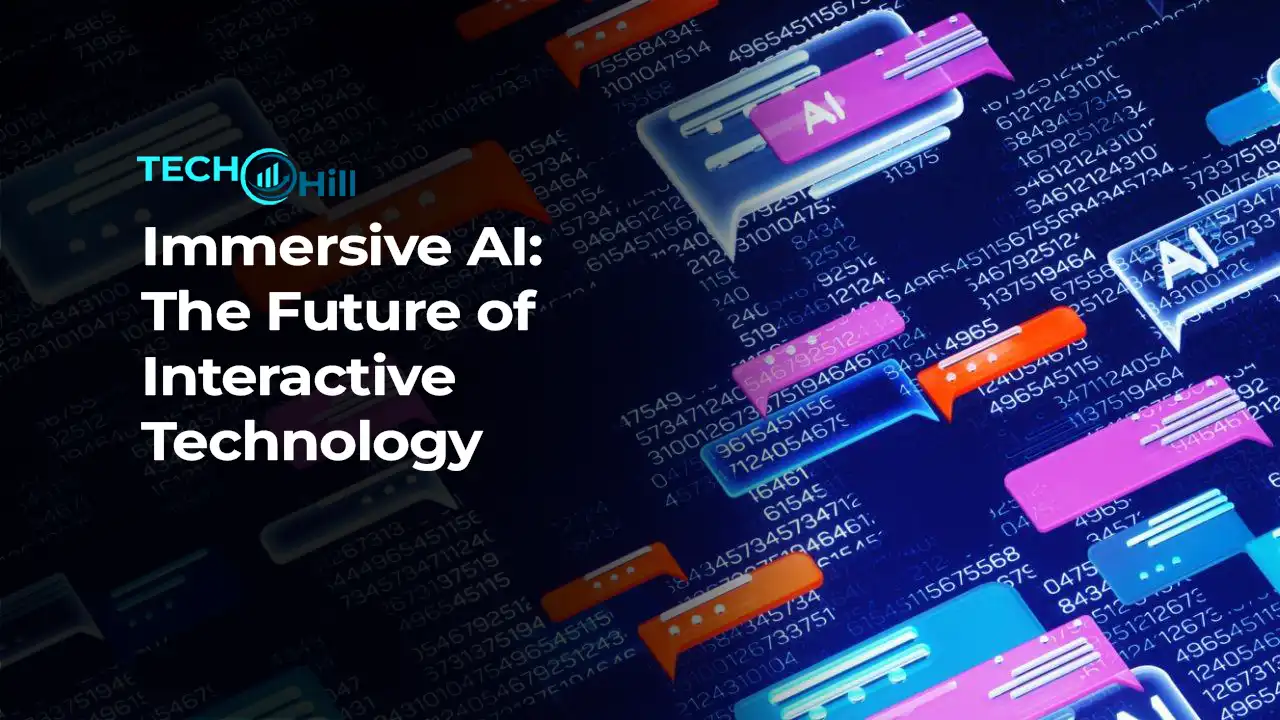Immersive AI: The Future of Interactive Technology

Imagine stepping into a world where reality and technology blend seamlessly, where the line between virtual and real becomes so blurred that you’re unsure where one ends and the other begins. This isn’t the distant future of sci-fi movies anymore—it’s today’s rapidly evolving world of Immersive AI. From personalized gaming experiences to virtual shopping assistants, Immersive AI is transforming how we interact with technology, creating environments that respond to our emotions, behaviors, and needs.
In this article, we’ll dive deep into Immersive AI, exploring its potential, importance, and the ethical considerations that come with its growing influence. We’ll also take a look at some free tools that allow anyone to experience this powerful technology, the applications across industries, and what the future holds for this exciting field.
What is Immersive AI?
Immersive AI refers to the integration of artificial intelligence with technologies like virtual reality (VR), augmented reality (AR), and mixed reality (MR) to create deeply engaging, interactive environments. It goes beyond traditional AI, which might be confined to chatbots or algorithms in the background. Immersive AI actively involves the user, adapting in real-time based on actions, decisions, and emotions.
For instance, imagine wearing a VR headset that not only allows you to explore a virtual world but also adjusts the environment based on your facial expressions. If you look confused or frustrated, the AI might offer subtle guidance or change the scenario to something less challenging. This is Immersive AI at work—creating experiences that are dynamic, responsive, and deeply personal.
At its core, Immersive AI aims to break down the barriers between humans and machines, offering experiences that feel as natural as walking through a park or having a conversation with a friend. Whether it’s through haptic feedback that simulates touch in virtual spaces or AI-generated environments that evolve as we interact, Immersive AI is set to revolutionize how we engage with technology.
Importance of Free Access
While the potential of Immersive AI is thrilling, access to these tools remains uneven. Advanced AI-powered immersive experiences often come with a hefty price tag, leaving many individuals and businesses unable to leverage the full potential of this technology.
However, the rise of free Immersive AI tools has democratized access, ensuring that more people can experiment, innovate, and incorporate these cutting-edge technologies into their daily lives. Whether you’re a student curious about virtual reality or a startup looking to create an interactive demo without breaking the bank, free tools provide an essential gateway.

Free access to Immersive AI also fuels innovation. When more people have access to these technologies, the pace of development quickens. New use cases, creative ideas, and unexpected innovations arise as individuals from diverse backgrounds interact with and adapt these tools to fit their unique needs.
Moreover, the availability of free Immersive AI tools ensures a more inclusive future, where the benefits of this technology can be enjoyed by people across different industries, geographies, and socioeconomic backgrounds. It levels the playing field, allowing small creators to compete with large corporations, fostering a culture of creativity and experimentation.
Examples of Free Immersive AI Tools
Let’s explore some of the top free Immersive AI tools that are making waves today:
1. Google ARCore: Google’s ARCore is an incredibly powerful platform that allows developers to create augmented reality experiences without needing expensive hardware. It leverages a smartphone’s camera and sensors to blend digital objects into the real world. Whether you’re a developer or just someone wanting to explore AR, ARCore offers an easy entry point.
2. Unity: Unity is a popular game development engine that is also widely used for VR and AR experiences. Unity offers a free tier that gives users access to powerful tools for creating immersive worlds. With Unity’s growing integration of AI technologies, creators can now design interactive experiences that adapt to users in real time.
3. Blender: Blender is an open-source 3D modeling tool that is used widely for creating immersive environments, characters, and objects. With its robust set of features and free access, it has become a go-to resource for creators looking to develop AI-powered interactive experiences, particularly for VR and AR applications.
4. DeepAR: is an AI-powered augmented reality platform that allows creators to build interactive filters, masks, and AR experiences—perfect for apps and social media platforms. It’s free for individual creators, making it a valuable tool for anyone wanting to experiment with immersive tech without major investments.
5. Lumen5: For those looking to dive into AI-driven video creation, Lumen5 is a free tool that uses AI to transform text into immersive video presentations. While it’s not AR or VR, it’s an excellent example of how AI can be used to create compelling, immersive content in a different medium.
Applications of Immersive AI
The impact of Immersive AI can be felt across various industries. Let’s explore some of the key applications:
1. Healthcare: In healthcare, Immersive AI is being used for training medical professionals through simulations that mimic real-life surgeries and procedures. Virtual environments allow surgeons to practice complex surgeries, and AI provides real-time feedback based on the user’s performance. For mental health therapy, Immersive AI tools are being developed to create calming, interactive environments for patients dealing with anxiety or PTSD, allowing them to practice mindfulness in a safe space.
2. Education: Education is being transformed by Immersive AI as well. Imagine students walking through ancient civilizations in history class or exploring the solar system in a science lesson—all from their classrooms. Immersive AI is enabling interactive learning experiences that engage students in ways that traditional methods simply can’t match.
3. Retail and E-Commerce: In retail, Immersive AI is revolutionizing the shopping experience. Consumers can use AR to virtually try on clothes, preview furniture in their homes, or receive personalized shopping recommendations based on their interactions within virtual stores. AI-powered avatars that act as personal shopping assistants are becoming more common, offering a seamless blend of convenience and interactivity.
4. Entertainment and Gaming: The gaming industry is perhaps the most obvious beneficiary of Immersive AI. Games now use AI to create dynamic, evolving environments that respond to players’ actions and emotions. In addition, virtual reality experiences enhanced by AI can create lifelike environments and NPCs (non-playable characters) that react as if they were real humans, providing gamers with a fully immersive experience.
5. Tourism: Virtual tours have become a popular use case for Immersive AI in the tourism industry. Potential travelers can explore destinations through VR before deciding on their next vacation. With AI enhancements, these virtual tours can be personalized based on users’ preferences, offering suggestions and adjusting the tour according to individual tastes.
Ethical and Privacy Considerations
With the advancement of Immersive AI comes a set of ethical and privacy challenges. As AI systems learn to read and respond to our emotions and behaviors, questions arise about the storage and use of personal data. For instance, an immersive experience that adapts to your emotional state will need to collect data about your facial expressions, body language, and possibly even biometric data like heart rate.
Privacy concerns center around how much data is being collected and who has access to it. If improperly managed, this sensitive information could be exploited, leading to unwanted surveillance or manipulation of users. Additionally, as Immersive AI becomes more prevalent in marketing and retail, there’s the potential for users to be nudged into making decisions based on emotional manipulation rather than informed choice.
Another ethical issue is related to accessibility. While free tools exist, creating high-quality Immersive AI experiences can still be cost-prohibitive for many. This could exacerbate the digital divide, where only certain groups have access to the full benefits of immersive technologies.
Future of Immersive AI
The future of Immersive AI is filled with possibilities. As technology continues to evolve, the potential for even more personalized, adaptive experiences will grow. AI-powered virtual assistants could become commonplace in our daily lives, assisting us with everything from shopping to education in ways that feel completely natural and intuitive.
In addition, 5G networks will enhance the capabilities of Immersive AI, providing the bandwidth needed for smoother, more responsive experiences. The rise of brain-computer interfaces (BCIs) could also offer unprecedented levels of immersion, where AI responds directly to our thoughts and feelings rather than physical movements or expressions.
However, as with any technology, the key to a successful future lies in responsible development. We must ensure that privacy concerns are addressed, that the technology remains accessible, and that ethical guidelines are in place to protect users.
Conclusion
Immersive AI is more than just a trend—it’s a revolution in how we interact with technology. From virtual shopping assistants to medical training simulations, Immersive AI is creating experiences that are dynamic, personal, and highly interactive. And with the growing availability of free tools, this technology is becoming more accessible to everyone.
However, as we embrace this exciting future, we must also be mindful of the ethical and privacy challenges that come with it. By fostering responsible innovation and ensuring that these tools are used for the benefit of all, we can unlock the full potential of Immersive AI and create a world where technology enriches our lives in ways we never thought possible.
